Historically, the “platform” refers to an organizational structure for political activity and revolution that emphasizes collective work, and “encourages inclusivity” through setting up alternative systems for sharing resources [1]. Before the advent of the Internet, art groups such as the New York Correspondence School, the International Mail Art Network, the Nouveau Réalistes, and Fluxus enacted this idea of the platform by taking advantage of communication technologies like the postal system as paths for sharing ideas.
#exstrange taps into the idealism of this vision by utilizing online commerce as a tool for interconnection, shared interests, social responsibility and exchange. We see eBay as an economical platform offering artists access to worldwide networking activity. The encounter between the machine and the human has the potential to disrupt existing systems of value and production of knowledge. We think this mode of work will transform already existing transactional forms into forms of exchange between humans across geographical, social and political boundaries.
We consider the projects presented on this page to be within the family of #exstrange. Help us to extend this family by sending news of other projects to curators@exstrange.com.
1. Olga Goriunova, Art Platforms and Cultural Production on the Internet (New York: Routledge, 2012), 8.
http://www.ebay.com/itm/A-Tool-to-Deceive-and-Slaughter-2009-Caleb-Larsen-/292000225567?
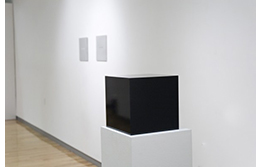
Perpetual online auction, internet connection, custom programming and hardware, acrylic cube.
Combining Robert Morris’ Box With the Sound of Its Own Making with Baudrillard’s writing on the art auction this sculpture exists in eternal transactional flux. It is a physical sculpture that is perpetually attempting to auction itself on eBay.
Every ten minutes the black box pings a server on the internet via the ethernet connection to check if it is for sale on the eBay. If its auction has ended or it has sold, it automatically creates a new auction of itself.
If a person buys it on eBay, the current owner is required to send it to the new owner. The new owner must then plug it into ethernet, and the cycle repeats itself. (From Caleb Larsen’s website: http://caleblarsen.com/a-tool-to-deceive-and-slaughter/ )
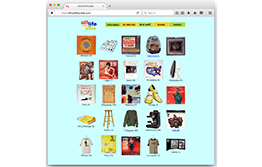
All My Life for Sale is a project that includes a book, an online site and a 2005 museum installation at the Everson Museum of Art in Syracuse, New York. In 2000, John D. Freyer decided to sell the entire contents of his apartment in Iowa City, Iowa on the auction website eBay. His sold possessions numbered more than 600, not including the hundreds he parted with at a subsequent yard sale. Freyer wrote histories for each of his objects, among them his favorite shirt, false teeth and Jesus nightlight, to entice potential online buyers. This became the online performance project known as AllMyLifeForSale.com, which became a national phenomenon among collectors of popular culture and internet enthusiasts alike who competed for a piece of John Freyer’s life. After tracking his sold possessions, Freyer visited and interviewed as many of the new owners as he could to ascertain what had attracted them to the objects. He maintained an online travelogue on his cross-country adventures, developed a project Web site, allmylifeforsale.com, and released the publication All My Life for Sale (Bloomsbury USA) in 2002. (From John D. Freyer’s website)
http://ellyclarke.com/index.php?/video/alternative-funding-strategy-india/
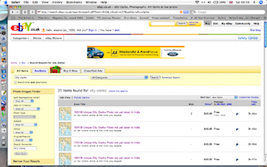
To fund a trip I made to India in January/February 2008 to research a film project that I never made in the end, I sold ‘Unique Elly Clarke Mobile Phone Photo not yet taken in India, Jan-Feb 2008’ via ebay.co.uk. For one month I pledged to take one photo a day with my Sony Ericcsson mobile phone at the time the buyer requested (by sms) and to send them a single edition signed print in the post. (From Elly Clarke’s website)
http://ellyclarke.com/index.php?/video/alternative-funding-trans-siberia/
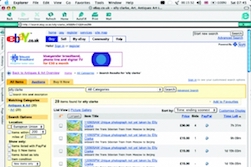
To raise money so I could attend the Trans Siberian conference I was invited to join in 2005, I sold photos I had not yet taken via ebay.co.uk. I pledged to take two photo a day – one at 10am, the other at 4pm for the 10 day duration of the journey with my analogue camera. When I returned to the UK I sent single-edition, signed, rubber-stamped prints to the buyers along with a contact sheet and list of titles.
The series has since been turned into a limited edition set of 21 postcards.
(From Elly Clarke’s website)
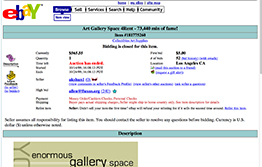
“On Oct.15, 1999, a collective at the California Institute of the Arts in Valencia, known as the AKSHUN group put the school’s main gallery up for auction on popular internet auction house eBay. The AKSHUN collective auctioned a week of gallery time, or, as they put it, 73,440 minutes of fame.
This sale began as a commentary on pay-to-play gallery spaces and specifically the lottery system for galleries at CalArts and the resulting competitive environment that system led to. The group began promoting the gallery auction at other LA art schools thinking it could be interesting if someone from another school ended up purchasing the space. There was a lot of competition between the art schools in LA at this time and the collective saw this as another layer. They continued to publicize the sale using arts list servers nationally. The space was eventually purchased by Allen Bukoff the director of Fluxus Midwest. He then kept the project going by reselling the gallery space by the square foot and flew out from Michigan to photograph each square foot that he had sold.” (From the Press Release of the auction-intervention by AKSHUN)
KLONDIKE: International Fluxus Group Show at CalArts archive, which was originally auctioned off on eBay by AKSHUN, is archived here: http://www.fluxus.org/FluxusMidwest/klondike/invitation.html
Further reference for the AKSHUN work is at: http://www.robertatkins.net/beta/shift/online/auction.html and http://archive.wired.com/politics/law/news/1999/10/32070?currentPage=all
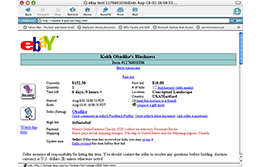
Keith Townsend Obadike attempted to sell his blackness on eBay as a net.performance. The description of what buyers would obtain in exchange for money was full of ironic but elusive references to the history of objectifying black bodies in the slave trade and the contemporary commodifying of black culture. He received a wide range of responses from eBay visitors, black entrepreneurs, and European net.art curators. Four days after posting his “item” Keith’s sale was terminated by eBay, the reason given was that it was found “inappropriate”. In the following interview he assesses the reception of his net.performance and the colonialist underpinnings of the navigational vocabulary of the internet. (From an interview of Keith with artist and critic Coco Fusco: http://blacknetart.com/coco.html)
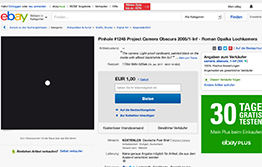
Camera Obscura 2005/1-Inf is a worldwide project in which two holes of a twin-holed pinhole camera are being auctioned simultaneously on Ebay every week. This project is dedicated to the polish artist Roman Opalka and his work 1965/1-∞. The highest bidders in each case receive one after the other a pinhole camera loaded with a piece of unexposed sheet of 5×7 Inch b/w film. They punch a hole with the enclosed needle and expose their own photograph in turn. Because of the minimal distance between the two holes the two photos overlap partly, so that a joint picture emerges, created by two people in different parts of the world. In the course of time a sort of photographic global puzzle will emerge – one continuous series of parallel exposures. At a later date the cameras will be displayed together with the parallel exposures in a permanent exhibition in the Galerie Merid in Stuttgart. They will also be published on this Internet site. (From http://www.camera-obscura-1-inf.net/index.html)
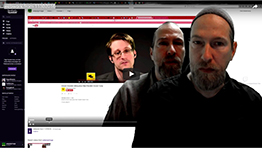
CuratingYouTube is a set of curated exhibitions and tool for curation that allows selecting and presenting chosen videos in a grid, where they can be played together, one after another, or separately. Orchestrating individual videos in a collective fashion technically lends itself not only to presenting outstanding single videos in relation to each other, but to the exploration of the generic element in aesthetic work. (From Goriunova, O 2016, “Participatory Platforms and the Emergence of Art”. in C Paul (ed.), A Companion to Digital Art. Blackwell, 305.)
The CuratingYouTube (CYT) project explores how the mainstream video production and distribution enabled by YouTube has impacted professional and amateur artistic creation. To do so, Robert Sakrowski devised a software-based tool for curation, Gridr, which enables users to aggregate YouTube content in visual grids, giving life to what he named the “[CYT] HTML soundbank” (Sakrowski, A.2.1). The CYT soundbank functions as a matrix for assemblages of audio-visual material taken from YouTube:7 it can be experienced as an artwork and an exhibition, especially when it combines more than one video assemblage. (From R. Sakrowski, “Interview about CYT and An Acoustic Journey Through YouTube,” Interviewed by Marialaura Ghidini, transcript of Skype conversation, March 24, 2013, 9am GMT, London.)
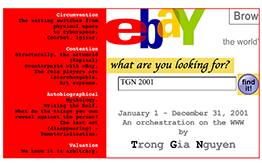
From January 1 to December 31, 2001, Nguyen produced a complete INVENTORY of everything in his Brooklyn studio/apartment using Ebay as the mechanism, thus playing all the roles on the website that normally exist in the art world (artist, curator, auctioneer, etc.). Every object was photographed and described similarly to condition reports at museums. In addition, Nguyen subversively embedded additional projects within the project, including selling “conceptual objects” (such as “Nothingnesss”) and incorporating a “live photo album” that involved the artist shooting an image each day and auctioning it on Ebay that same evening. There were 1001 auctions total, and Nguyen subsequently published these records as an encyclopedic set a decade later.
http://greg.org/archive/2015/03/07/untitled_do_not_bid_or_buy.html
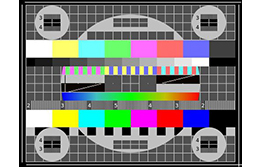
“eBay developers create test listings to debug features and settings, or for Power Users to preview and QA their regular listings. These auction listings have esoteric acronyms and abbreviations for titles, and images that range from stock to baffling to perfect. And they are full of warnings like TEST ITEM DO NOT BUY OR BID, and NO ITEM EXISTS NO FEEDBACK GIVEN. Artist Greg Allen appropriated the titles, texts, prices, shipping conditions, and images of test listings created by the eBay developers, and sold them as actual prints. The project was repeatedly complicated by eBay’s TOS restrictions on the use of certain text (e.g., DO NOT BID OR BUY, which has a contentious history of use as a protest tool by disgruntled eBay sellers) and certain categories (i.e., completing actual sales for test listings), which felt useful for examining the assumptions built into all our platforms for art, whether online or IRL.” (From the artist website)
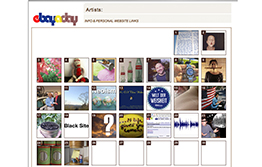
The first group curatorial project on eBay, eBayaday consisted of 25 auctions (one debuted each day for a month). Works presented in the show exploited, redefined or underscored eBay’s potential in the exchange of ideas, objects and money.
https://www.kickstarter.com/projects/ksouth/exhibition-kickstarter
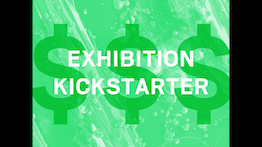
“I’ve created this Kickstarter campaign to experiment with new form of art exhibition and approach to selling work. I’ve asked 11 artists to create new works that fit into the Kickstarter format. In response, they have each designed a custom artwork through online retailers in editions of 10, and assigned a value for these mediated works.
Throughout the course of this campaign, I’ll be interviewing the artists, educators, writers, and other interested parties about where the art world stands today–both as an institution and a means of livelihood–and how crowd-funding may continue to impact the economy of artistic practice.
Opening October 11th, the culmination of this project will be presented at Ditch Projects, a gallery in Springfield, Oregon. The physical exhibition will display a single edition of each artwork, as well as the video documentation.” (From the project Kickstarter page).
https://www.kickstarter.com/projects/jeremybailey/important-portraits
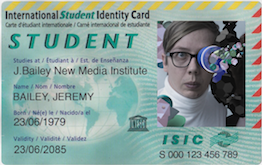
“I am creating a series of important augmented reality portraits of YOU, the under-appreciated KickStarter backer, to be exhibited in a solo exhibition at Pari Nadimi Gallery April 4th – May 4th 2013.
As an artist, when I look around Kickstarter all I see are the creators, where are the backers? I’ve been an artist long enough to know that art is about who pays for it. How can important people be satisfied helping others without being recognized themselves? The powerful and wealthy patron should be celebrated the way they have been in the past, in grand portraits commissioned and hung on the walls of museums and galleries. […] I want to reveal your true inner essence in your very own 21st century augmented reality portrait. As a Famous New Media Artist I have access to the latest techniques and technology, everything necessary for you to truly express yourself is at my fingertips. I’ve been making myself look amazing in augmented reality self portraits for over 10 years and I’ve decided it’s time to help others look as great as I do.” (From Important Portraits‘ Kickstarter page)
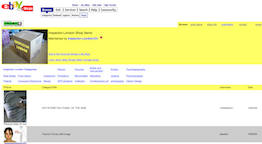
Inspector London – from Marx to Mobiles The consumer as designer/producer – a sketch of contemporary consumption/production landscapes.
“Virtual marketplaces such as eBay are symptomatic of the tendencies of innovative consumer involvement in the determination of the product within the wider current consumption landscape. Established as the alternative marketplace worldwide eBay created a new exchange process. Similar to catalogue purchasing systems goods can only be evaluated through information /documentation provided by the seller. Actual physical contact with the object is deferred until the point of delivery. The crucial difference is that, rather than the standardised, objectified information provided by most consumer spaces, such as supermarkets or catalogues, the shelves of eBay have been reclaimed by the language and imagery of the individual. Products here are photographed from within and bare the trace of home environments of mini-entrepreneurs and living-room niche-service industries. Significantly evaluation of the offered product relies more on the imagination of buyers evaluating the symbolic information provided and therefore on pre-existing knowledge rather than physical contact with the objects at the time.” (From the Inspector London Info Page)
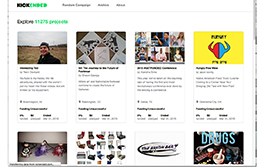
“Three things to know about Kickended:
1. Kickended is an archive of Kickstarter’s $0-pledged campaigns.
Kickended is the place where campaigns with no backers live a second life. Free from the pressure of money raising, these retain the purity of abstract ideas.
2. Kickended used to grab data from kickspy.com.
In short, Kickspy was a means to easily discover, research and track Kickstarter projects. Kickspy was originally started in October 2012 by Walter Haas and came out of his passion for backing Kickstarter projects and his frustration at not being able to find them more easily. Kickspy made the hard decision to shut down on 31st March 2015 for unspecified reasons. If you know of a similar online service, feel free to drop a line.
3. Kickended was made by Silvio Lorusso.”
(From the About page of the Kickended website)
https://web.archive.org/web/19991006042915/http://www.bigrigindustries.com/cheesy/

Kraft Macaroni & Cheese dinner “I’m A Blue Box Kid!” from the “I want the Blues” contest 1997This is the highly sought after Blue Box Kid box of Grand Prize Winner, Natasha, age 5, Illinois. Little Natasha is so cute with her adorable baby teeth smiling at us, a true jewel, a diamond in the rough, [as they say: “…sugar and spice and everything nice…”].
Package condition: Slight crushing on the cardboard down near the bottom lefthand corner, other than that this is mint, unopened! Macaroni and cheese packet is well preserved inside. This is the 7.25 oz size (206 g) of the cheesiest original flavor M & C dinner, expiration date March 7th, 1999. This is the real thing!
WARNING: I *will* eat this box for dinner if reserve is not met!!!$3.00 priority mail (4.00 outside of US) People with negative feedback pay by money order only. No Kraft employees may bid on this item. The value on this item is getting astronomical, BID NOW! $20 Reserve.

This artwork undermined the idea of having a company “on paper” in countries considered financial offshore centers. The artist unveiled over 200000 Cayman Islands companies and reversed global finance machination through conceptual art. The website Loophole4All.com promoted the sale of real identities of anonymous Cayman companies at low cost to democratize the privileges of offshore businesses by forging Certificates of Incorporation documents for each company, all issued with the artist’s real name and signature. This performance generated international media attention, engaged an active audience and drew outrage from authorities on the Cayman Islands, international law and accounting firms, PayPal, and real owners of the companies. Further, the artist interviewed major experts and produced a video documentary investigating offshore centers to expose their social costs and to envision solutions to global economic inequality. In the offline art installation, the paper trail of the project is displayed with prints of the counterfeited Certificates of Incorporation and the documents of the scheme set up for the operation. (From: https://paolocirio.net/work/loophole-for-all/)

Not Only Cigarettes was a new video art exhibition format created in order to be shown through the screen of a cigarette vending machine. The project run both in real life (IRL), on a physical vending machine in Viareggio (Italy) and, URL, on the Green Cube Gallery exhibition space.
Luca Leggero transformed the integrated screen of a common vending machine into a video art display. This machine, which is located on the sidewalk outside a bar, is visible by drivers and random people who pass by. It works 24 hours a day streaming video art on loop to an unexpecting audience.
The exhibition opened on Friday 15th February at Bar Tabaccheria Marin in Viareggio (Italy) and until April 2nd 2019, the machine looped one of the 32 participating artists!
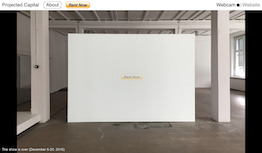
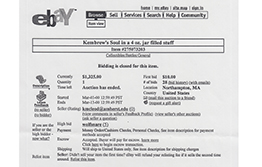
After selling his soul, packaged in various forms, beginning in the late 1980s, McLeod sold his soul on eBay in 2000. He writes:
After the story broke, for about a week I spent my afternoons on talk radio shows getting into theological arguments with people over whether or not my soul was a renewable resource that could be bottled. When talking to reporters I played it straight, though I also tossed out plenty of clues that allowed them to form their own opinions about how serious I was. During interviews, I played a greedy capitalist who was out to make money and who was prone to say things like, “The great thing about America is that you are rewarded for selling your soul. That’s what makes this country great. I’m sure Jesus was a free market capitalist.” Or “I may not have a soul, but I have a new car, and I’m doing great.” (From the artist website)

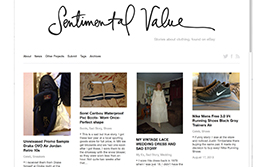
Emily Spivack’s web-based art project Sentimental Value connects the age-old desire to tell stories through special objects with the easily accessible platform of the Internet. Spivack has recognized a new vernacular mode of expression emerging in the personal narratives accompanying clothing for sale on eBay, which has unintentionally become a repository of surprisingly personal anecdotes and memories. Spivack has been collecting and documenting these stories in all their raw honesty on the Sentimental Value website and acquiring the objects in the process. (From http://www.philartalliance.org/exhibition/emily-spivack-sentimental-value/)

Shop Mandiberg was an e-commerce site which aimed to market and sell every last one of Michael Mandiberg’s personal possessions. Everything was for sale, from his underwear to his favorite coats ‹ his apartment keys, to his mostly used jar of strawberry jam.
Shop Mandiberg was both e-commerce and performance net.art. As performance net.art Shop Mandiberg has attracted the attention of such art print media sources as the New York Times and the Chicago Tribune, and as e-commerce the site has been documented in the Industry Standard, and the Berliner (Germany) Zeitung. (From http://www.mandiberg.com/shop-mandiberg/)

(From the Significant Objects website)
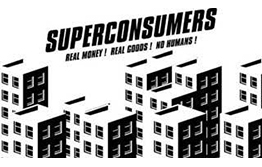
What happens when a computer programme starts buying and selling stuff on Internet auctions like eBay autonomously? That is the key question of superconsumers. The stuff the Bot has bought is exhibited for a short time. Thus digital values are translated into tangible goods. And vice versa, since the Bot sells them again after a while to buy new ones. In this way, commonplace products are temporarily translated into works of art. The basic principle of superconsumers, is to make an amount of money available to a software (a so called “bot”). The software uses this money to buy goods autonomously at the online-auction-platform ebay, transfers these goods to an art-space, exhibits them and sells them again via eBay. (From the Turbolence archive, http://archive.turbulence.org/blog/2006/11/10/interface-and-society/)
http://futuregallery.org/brad-troemel-the-edwards-copy-1796-2014/
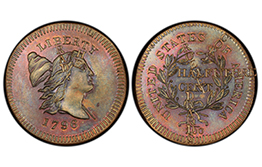
“When I made counterfeits to be sold on eBay I would try to blend in too, to be real. I would purchase educational counterfeits of colonial coins that were independently made in the 1780’s (prior to the Coinage Act of 1792 and subsequent creation of the Philadelphia mint). The first task would be to go to my driveway and use a brick to wear the coin down far enough so that the stamped COPY indentation was no longer visible. Next would be the chemical baths, …. I sold batches of three or so of these coins at a time, with the auctions spread at least a month apart. All listings worked from a elaborate descriptive template where I said the coins were repossessed from the home of a dead Italian mobster and that due to the great deal of wear and tear they display it’s impossible to determine their authenticity, though it’s safe to assume the coins have a ‘dubious’ provenance.… My collectors were people interested in telling tales about the things in their collections. Marketable things can be fit into concise oral descriptions- like conceptual artworks!” (From the artist website)
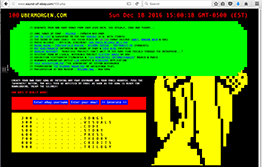
“We generate unique songs by using eBay user-data. You simply enter any eBay username (your own or someone else’s) and add your email address so we can notify you as soon as the song is ready for downloading. Then click “generate” and our robots sprawl out into the net to collect data. Then the robots bring back the data to our sc3 supercollider soundgeneration-engine. Finally, the complex software-machine starts generating a score-file which is then transformed into your unique but uniform song and presented in teletext porn style! We sell out your human needs digitally… The sound is cool, the machine produces masses of songs and replicates millions of times throughout the networks – flooding the net, a bubbling sea of artifical songs visualized in CONTEMPORARY teletext – a continental drift within a macromusic universal urban scape.” (From http://www.ubermorgen.com/EKMRZ_Trilogy/)
http://www.asquare.org/transformations-actions-to-matter-matter-to-actions/
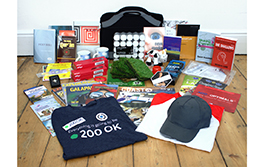
Transformations: Actions to Matter / Matter to Actions (2015 – ongoing) is a series of performative actions employing what is colloquial termed as the ‘free stuff’ online community. Each action occurs in two parts. Part one, titled Actions to Matter, consists of the artist acquiring physical items for free online. In part two, Matter to Actions, the acquired items are sold online. Transformations addresses three interrelated subjects. The first is the concept of transformation itself. Actions that are performed on the internet are considered to occur within a ‘virtual’ or digital context. Items that are acquired as a result of actions are physically manifested in ‘real’ contexts. Within the work a transformation occurs from ‘virtual’ to ‘real’ and then back to ‘virtual’ again. The internet is all at once the staging ground for initiating transformation, the final destination for the items acquired and the documentation produced. Combined the transformation from ‘virtual’ to ‘real’ and then back again form a transformative action. (From http://www.asquare.org/work/transformations/)
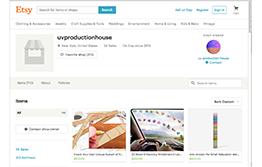
Ultra Violet Production House is an online Etsy store which provides customers with high quality material kits and fabrication guidance for all original works. Buyers assume responsibility for the realisation of materials received based on tutorials sent to them at the point of purchase. Products include a mobile SOLAR powered tanning canopy for Outdoors, an Acne jeans poppy planter, an interchangeable Vice Magazine Photo issue TYVEK backpack, a Hydrophobic Coated Floor Liquid Maze, and an Unbreakable Phone Case from Ballistics Gel, among others. (From https://etrigg.com/event/ultraviolet-production-house-joshua-citarella-and-brad-troemel/22190978/)
https://nettime.org/Lists-Archives/nettime-l-0003/msg00074.html
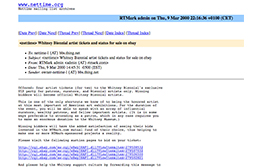
“Offered: four artist tickets (for two) to the Whitney Biennial’s exclusive VIP party for patrons, curators, and Biennial artists only. Winning bidders will become official Whitney Biennial artists. This is one of the only shortcuts we know of to being the honored artist at this most important of American art exhibitions. For the duration of the event, you will be able to speak with an array of influential curators, wealthy patrons, and fellow important artists. (It is in some ways preferable to attending as a patron, which in any case requires you to make an enormous donation to the Whitney Museum.)” (From the Nettime mailing list archives)
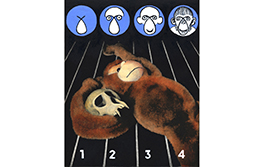
“In the Zero Sum Art Project, I explored the basic alchemy of artwork, that strange situation where base raw materials gain value through their transformation, in an enormous leap of faith, into art. Towards that end, the project was a self-contained studio in which all costs and profits were made visible to the viewer. Central to the project was an entirely absurd business plan that did not allow the studio to make a profit, and killed the studio if it stayed in the red. The seemingly poor business practice of putting every last cent of profit back into the studio, leaving the balance as close to zero as possible, always left the project teetering on the brink of disaster.
The money spent on materials and fees and any other specifically art related expenses was directly tied to the money brought in by the sale of the artwork, and this relationship was accessible to the viewer at all times. Ebay played a major role in this process, allowing the viewer to directly determine the value of the artwork through the bidding process. The starting bids for all auctions was based on the fees associated with the auction and the cost of materials in the artwork for sale (for purposes of this project, all of the artist’s “time” is “free”). Any money in excess of this amount that was raised from a successful auction had to be applied to the creation of future artwork.” (From Marc Snyder)